The new role of laser in manufacturing (3)
When it is necessary to cut high-grade ceramics, the hot processing method can make the process easier. Silicon nitride ceramics, which previously could only be machined with geometrically indeterminate cutters, can now be turned using the LAM process. With the prior art and the machine tool, the user has been able to turn the machining of the material into a complex shape part of the nitrogen silicon ceramic and obtain a surface roughness of up to Ra of 0.3 μm. These systems are integrated with a 3kW Nd:YAG laser on a lathe or a 1.2kW high power diode laser. Previous page 
Through cooperation with relevant industries and support from the German government fund, the Fraunhofer Institute has developed and manufactured a set of HPDL (a prototype of precision turning machine tools with high power diode lasers. The first one has complete industrial functions). The machine tool will be available in 1999.
In splitting and spinning turning, a semi-finished product can be selectively heated in a forming operation by a laser integrated on a spinning lathe. This heating process increases the temperature and forming speed and reduces strain hardening. Laser assisted spin forming reduces the required forming force, resulting in a lower degree of material hardening.
The laser-assisted spinning forming method can generate inner and outer teeth, formed contours, and complex geometries on symmetrical rotating body parts without using an annealing process at a clamping position. It avoids costly cutting processes, saves material, and produces lightweight, high-strength features.
Laser bending of the workpiece process is a new and versatile process that does not require any forming tools. With the non-contact laser machining process that produces the rebound effect, many forming tasks can be accomplished. During the bending process including the metal sheet, the temperature gradient in the part generates mechanical stress, thereby producing controlled plastic deformation. The laser bending process is suitable for making prototypes and small batch production. Currently, the Fraunhofer Institute is in the experimental research stage.
The demand for custom welded blanks in the automotive industry is on the rise. In order to better compete, vendors need a cost-effective system. The general scrap rate of laser blank welding systems is between 3% and 4%. Using a laser to cut the blank improves the welding speed and ensures a perfect clearance fit.
By integrating an edge preparation unit into the welding line, the typical body side weld cycle time can be reduced to 32s, and the door trim time can be reduced to 14s. The estimated cost of welding a side of the body is $3, and the estimated cost of welding a trim inside the door is $2. Another benefit is that such a system can weld both steel and aluminum blanks after making necessary modifications to the fixture and welding process.